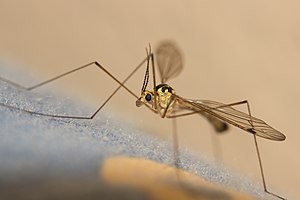Crow's snake
Due to formal or content deficiencies in the quality assurance biology in the section "Insects" for improvement, this article has been entered. This is done in order to bring the quality of the biology articles to an acceptable level. Please help improve this article! Articles that are not significantly improved can be deleted if necessary.
Read the more detailed information in the minimum requirements for biology articles .
| Crow's snake | ||||||||||
|---|---|---|---|---|---|---|---|---|---|---|

Spotted meadow snake ( Nephrotoma appendiculata ) |
||||||||||
| Systematics | ||||||||||
|
||||||||||
| Scientific name | ||||||||||
| Nephrotoma | ||||||||||
| Meigen , 1803 |
The crow's snakes ( nephrotoma ) are a genus in the order of the two-winged birds (Diptera). Crow mosquitoes belong to the family of Tipulidae (crane flies) to the type of spotted Tipula paludosa ( Nephrotoma appendiculata ) and are mostly found in North Africa and Europe.
features
Crow's snake can be easily distinguished from other species of gnat by its specific coloration. This genus can be recognized by its yellow and black markings on the head, chest and abdomen.
Their body length is on average between 16-25 mm with the females being slightly larger than the males.
Their wings are milky to transparent and have no spots. They roughly correspond to their body length. The edges of the wings are brown in color.
The very long legs are all on the thorax. The head is quite small in relation to the body and has an elongated shape. Two short feelers can be seen in the area around the compound eyes.
An important representative of the genus, the spotted meadow snake ( Nephrotoma appendiculata ), is predominantly crepuscular and behaves quietly in resting places during the day. In a mass occurrence, the larvae of the spotted meadow snake can cause considerable damage to plants. Otherwise the Wiesenschnake is harmless and not dangerous for humans or animals.
habitat
Their habitat mostly includes wet biotopes such as swamps, moors, heathlands, but also parks and gardens. Their distribution includes Europe and North America.
Development and reproduction
The first gnats appear from mid-June. During the summer time, these insects begin mating. After mating, the females shed the eggs in flight. The female can lay oval eggs between 300 and 400 millimeters in size. After about two weeks, the larvae begin to hatch.
At this stage, the larvae live in the soil and overwinter there. The larvae wake up again between April and May. When they have reached a size of approx. 4 cm, they pupate in June / July. After about 3 weeks a new generation of flies hatch.
nutrition
The crow's snake feeds on nectar and other exposed juices such as water .
The larvae feed on the roots of various plants. They also feed on potatoes, peas, grass and various types of grain.
swell
- ↑ Crow's Snap - Animal Documentary. Retrieved July 14, 2018 .
- ↑ Wilfried Funk: Insect box: Fleckte Wiesenschnake. Retrieved July 14, 2018 .
- ↑ Speckled Wiesenschnake - animal documentary. Retrieved July 14, 2018 .
- ↑ Wilfried Funk: Insect box: Fleckte Wiesenschnake. Retrieved July 14, 2018 .
- ↑ Speckled Wiesenschnake - animal documentary. Retrieved July 14, 2018 .
